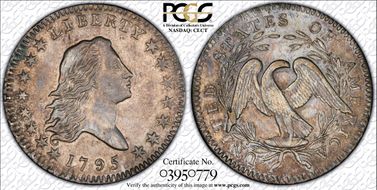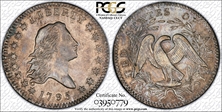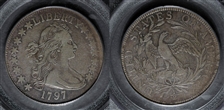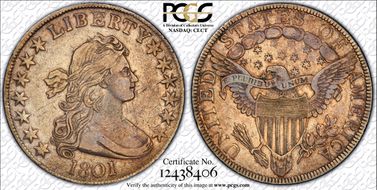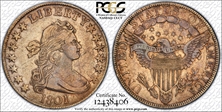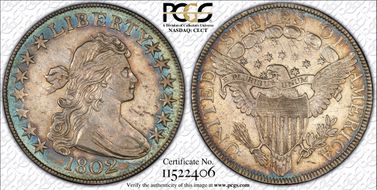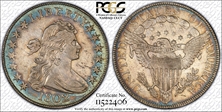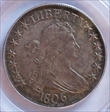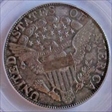Gobrecht's Raisinet Collection 的钱币相册
1795 50C 2 Leaves AU55. O-102, R.4. This piece is an intermediate die state, the obverse meeting Overton's requirements for O-102a and the reverse perfect as an O-102. It is also one of the finest known examples of the die marriage. In the fourth edition of Overton, Don Parsley recorded the Condition Census as 55, 45, 40, 30, 30. The finest examples to appear in recent auctions (and the only AU grade coins) are an AU55 ANACS piece that Heritage sold in November 2003 and an uncertified AU50 sold by Stack's in May 2001. Each side has a few minor scuffs and abrasions, but the overall eye appeal of this example is excellent. Satiny pale gray surfaces exhibit sharp design features with nearly full luster, accented by delightful gold and iridescent toning.
1795 50C 2 Leaves AU55. O-102, R.4. This piece is an intermediate die state, the obverse meeting Overton's requirements for O-102a and the reverse perfect as an O-102. It is also one of the finest known examples of the die marriage. In the fourth edition of Overton, Don Parsley recorded the Condition Census as 55, 45, 40, 30, 30. The finest examples to appear in recent auctions (and the only AU grade coins) are an AU55 ANACS piece that Heritage sold in November 2003 and an uncertified AU50 sold by Stack's in May 2001. Each side has a few minor scuffs and abrasions, but the overall eye appeal of this example is excellent. Satiny pale gray surfaces exhibit sharp design features with nearly full luster, accented by delightful gold and iridescent toning.
O-102 Low R.6. The rarest regular-issue US silver coinage design and solid for the grade. The Draped Bust, Small Eagle half dollar is one of the most difficult type coins to obtain, arguably the most difficult silver type coin, but not as rare as the 1796 No Stars quarter eagle or the 1808 quarter eagle. These half dollars, bearing the dates 1796 or 1797, come from a paltry mintage of 3,918 pieces, about 250 of which have survived the ravages of time. Half dollars of 1796-1797 are one of the rarest U.S. type coins and certainly one of the most expensive in virtually all levels of preservation. Even the most advanced collections often lack this rarity, and when present, it is usually in the low to middle grade levels, as here, and/or impaired, unlike this original, problem-free piece. There are four varieties of Draped Bust, Small Eagle half dollar. The first 1796 variety (Overton-101) displays 15 obverse stars, while the second has 16 stars (O-102). The two 1797-dated varieties (O-101 and O-102) share the same obverse but have different reverses, differentiated by the alignment of the peripheral lettering in relation to the central devices. The reverse of the 1797 Overton-101 variety was originally paired with the 1796 15 stars and 1796 16 stars obverses. During its use with the latter obverse, the reverse die developed a crack from the tip of the palm leaf below the base of the F in OF through the right side of O to the milling. This reverse developed even more cracks shortly after it was paired with the 1797 obverse die (O-101) and soon began to break up (O-101a). The breakup of the reverse die used in the 1797 Overton 101 and 101a varieties resulted in the employment of a new reverse die. The O-102 reverse differs from the old reverse in that the peripheral lettering is slightly offset in relation to the wreath.
1801 50C VF30. O-102, High R.4. Slightly more than four years lapsed from the last delivery of half dollars in 1797 (May 26), until the first delivery in 1801 (August 14). The obverse remained the same as the 1796-1797 Fillet Head design, but the reverse was an entirely new design. It has traditionally been attributed to Robert Scot, and the Heraldic Eagle reverse was first used on 1796 quarter eagles (1795 Heraldic Eagle half eagles were not coined until 1798). When half dollar coinage resumed in 1801 for the first time since the fabulously rare 1796-97 coinage, the total production was a meager 30,289 coins for the year. This coin is a representative of the less common of two die pairs for this rare date, with a normal set of arrowheads on the reverse. Only two varieties are dated 1801, both of which share a common obverse die, but the reverses are promptly distinguished by checking for prominent die lumps near the arrowheads. They are present on O-101 but absent on the elusive O-102. The combination of a Draped Bust obverse and Small Eagle reverse appeared on the half dollars of 1796 and 1797. In 1801 the Mint again struck examples of the denomination, this time with the new Heraldic Eagle reverse design that was patterned after the Great Seal of the United States. Survivors are mostly in lower grades. The average certified grade is in the VF range. The present piece is the more scarce variety, and 1801 is the first and most elusive date of the Heraldic Eagle type half dollar. This example displays an attractive reddish-gray and green patina. Although the stars are flat, the devices have bold detail. E PLURIBUS UNUM is clear and the obverse has numerous adjustment marks at the base. The two reverse dies for the year are distinguished by the presence or lack of a large 'tail' on the R in LIBERTY. The O-101, which has the tail, is somewhat less scarce. As mentioned above, the O-101 variety features two die lumps (as struck) on the lower left reverse quadrant near the arrowheads, which also identifies the die marriage.
1801 50C VF30. O-102, High R.4. Slightly more than four years lapsed from the last delivery of half dollars in 1797 (May 26), until the first delivery in 1801 (August 14). The obverse remained the same as the 1796-1797 Fillet Head design, but the reverse was an entirely new design. It has traditionally been attributed to Robert Scot, and the Heraldic Eagle reverse was first used on 1796 quarter eagles (1795 Heraldic Eagle half eagles were not coined until 1798). When half dollar coinage resumed in 1801 for the first time since the fabulously rare 1796-97 coinage, the total production was a meager 30,289 coins for the year. This coin is a representative of the less common of two die pairs for this rare date, with a normal set of arrowheads on the reverse. Only two varieties are dated 1801, both of which share a common obverse die, but the reverses are promptly distinguished by checking for prominent die lumps near the arrowheads. They are present on O-101 but absent on the elusive O-102. The combination of a Draped Bust obverse and Small Eagle reverse appeared on the half dollars of 1796 and 1797. In 1801 the Mint again struck examples of the denomination, this time with the new Heraldic Eagle reverse design that was patterned after the Great Seal of the United States. Survivors are mostly in lower grades. The average certified grade is in the VF range. The present piece is the more scarce variety, and 1801 is the first and most elusive date of the Heraldic Eagle type half dollar. This example displays an attractive reddish-gray and green patina. Although the stars are flat, the devices have bold detail. E PLURIBUS UNUM is clear and the obverse has numerous adjustment marks at the base. The two reverse dies for the year are distinguished by the presence or lack of a large 'tail' on the R in LIBERTY. The O-101, which has the tail, is somewhat less scarce. As mentioned above, the O-101 variety features two die lumps (as struck) on the lower left reverse quadrant near the arrowheads, which also identifies the die marriage.
O-101, R.3. Toned with lovely deep peripheral blue which extends beyond the obverse stars and reverse legend to the rim. A similar number of 1802 halves were struck when compared to the 1801: 29,890 pieces compared to 30,289 of the 1801. But for a series with so many die varieties and even sub-varieties, the 1802 half dollar mintage is a lesson in contradiction, as the 29,890 pieces recorded struck were produced from a single die pair. There are no others known for the date, and after 200+ years it is highly unlikely, although not impossible, that any others will be found. The year 1827 holds the series record for the greatest number of die marriages. The 28 obverse dies and 34 reverse dies were married in 49 different combinations to produce the 5.5 million pieces for the year, for an average of more than 112,000 halves per pair. In the case of the 1802, then, it is little wonder that the Mint personnel even saw fit to reuse master dies from 1801 to produce the working dies for 1802: After all, that mintage amounted to only one-quarter of the average mintage for a single die pair in 1827. The 1802 also bears the distinction of being the only Draped Bust half that is a single-variety year. (The 1815, a Capped Bust design, is a single-variety year as well.) While the reasons for the relatively small mintage are lost to posterity, it bears mentioning that the other silver denominations produced during the year, the half dime and dime, are also small by series standards, with the half dime a legendary rarity. (The difference, of course, is that most yearly mintages of the early half dime and dime were on the smallish side, while the silver half dollar, along with the large cent and gold half eagle, was one of the three workhorse coinage denominations of early U.S. commerce.) Mint State coins of this issue are quite rare. Only two Mint State pieces have been recorded in recent auction appearances, so there is considerable pressure on the dozen or so AU coins that have made the rounds in recent auctions. This piece apparently falls just outside the traditional Condition Census of the top six examples, with at least half a dozen finer examples known. The design elements on the present coin are sharply defined, though the star centers along the left border are weak. Attractive cobalt-blue, lavender, and gold-brown patina is evident on the obverse periphery, and lesser so on the reverse periphery. Traces of luster are seen in the recessed areas, and the relatively clean surfaces are devoid of significant marks. Diagonal adjustment marks are present in the upper and central reverse.
O-101, R.3. Toned with lovely deep peripheral blue which extends beyond the obverse stars and reverse legend to the rim. A similar number of 1802 halves were struck when compared to the 1801: 29,890 pieces compared to 30,289 of the 1801. But for a series with so many die varieties and even sub-varieties, the 1802 half dollar mintage is a lesson in contradiction, as the 29,890 pieces recorded struck were produced from a single die pair. There are no others known for the date, and after 200+ years it is highly unlikely, although not impossible, that any others will be found. The year 1827 holds the series record for the greatest number of die marriages. The 28 obverse dies and 34 reverse dies were married in 49 different combinations to produce the 5.5 million pieces for the year, for an average of more than 112,000 halves per pair. In the case of the 1802, then, it is little wonder that the Mint personnel even saw fit to reuse master dies from 1801 to produce the working dies for 1802: After all, that mintage amounted to only one-quarter of the average mintage for a single die pair in 1827. The 1802 also bears the distinction of being the only Draped Bust half that is a single-variety year. (The 1815, a Capped Bust design, is a single-variety year as well.) While the reasons for the relatively small mintage are lost to posterity, it bears mentioning that the other silver denominations produced during the year, the half dime and dime, are also small by series standards, with the half dime a legendary rarity. (The difference, of course, is that most yearly mintages of the early half dime and dime were on the smallish side, while the silver half dollar, along with the large cent and gold half eagle, was one of the three workhorse coinage denominations of early U.S. commerce.) Mint State coins of this issue are quite rare. Only two Mint State pieces have been recorded in recent auction appearances, so there is considerable pressure on the dozen or so AU coins that have made the rounds in recent auctions. This piece apparently falls just outside the traditional Condition Census of the top six examples, with at least half a dozen finer examples known. The design elements on the present coin are sharply defined, though the star centers along the left border are weak. Attractive cobalt-blue, lavender, and gold-brown patina is evident on the obverse periphery, and lesser so on the reverse periphery. Traces of luster are seen in the recessed areas, and the relatively clean surfaces are devoid of significant marks. Diagonal adjustment marks are present in the upper and central reverse.
1806 50C Pointed 6, Stem MS63. O-120a, R.4. A huge mintage of 839,576 Draped Bust half dollars was achieved in 1806, with 28 die varieties known for the date. A collection of 1806 die varieties and states would provide a monumental challenge. The O-120 reverse is one of those few numismatic situations where virtually every surviving coin could be considered a slightly different die state. This scarce variety is most easily identified by the die crack above the hair of Liberty on the obverse, and especially on the reverse by the broken patch on the shield, which gives the coin a special character not found on other varieties. Known as the Broken Shield variety, in its intermediate and late die states this variety is instantly recognized by (and popular for) the unusual, heavy die break, or "cud." A large piece broke out of the die right across the shield on the reverse, atop the fourth vertical stripe of the shield its earliest stages of progression. In later die states, this cud eventually extends across the shield until only the first vertical stripe is unaffected. This example is an intermediate state and is much earlier than that plated in the Parsley/Overton book. The shield die break encompasses all or part of three vertical stripes. The die break extends from pale 2 of gule 3 to a point midway between gules 5 and 6. Another break joins the left part of the first two horizontal shield stripes. Two die cracks join the border to the right ribbon end below M of AMERICA. These start at the same point on the border, with one crack following the right diagonal of the A, the other curving through M, with the area between these just beginning to sink into a retained cud. An additional crack extends through the tops of UNITE to the border over D. Many diagnostic die cracks are evident, including the crack across the tail feathers and the crack from the leaf to the base of RI. A couple light scratches in the right obverse fields serve to mark the pedigree of this piece, an intricately struck half dollar that lacks consequential abrasions. The actual design elements on each side of this lovely Draped Bust half dollar are boldly defined, within the context of the design type, with a well-centered impression and full obverse and reverse border details. The strike is crisp and full, with clear details even on the eagle's breast feathers, although a few of the upper hair details are weakly defined, as nearly always. The dusky grayish-silver colored obverse has considerable underlying mint luster, with iridescent tones of gold, pastel pink, sky blue and sea green circling the borders. The reverse has similar toning throughout and shimmering luster, swirling atop exceptional surfaces with none of the scratches mentioned for the obverse. This Select Mint State coin is a phenomenal example of this scarce variety, and one of the two or three finest known of the die state.
1806 50C Pointed 6, Stem MS63. O-120a, R.4. A huge mintage of 839,576 Draped Bust half dollars was achieved in 1806, with 28 die varieties known for the date. A collection of 1806 die varieties and states would provide a monumental challenge. The O-120 reverse is one of those few numismatic situations where virtually every surviving coin could be considered a slightly different die state. This scarce variety is most easily identified by the die crack above the hair of Liberty on the obverse, and especially on the reverse by the broken patch on the shield, which gives the coin a special character not found on other varieties. Known as the Broken Shield variety, in its intermediate and late die states this variety is instantly recognized by (and popular for) the unusual, heavy die break, or "cud." A large piece broke out of the die right across the shield on the reverse, atop the fourth vertical stripe of the shield its earliest stages of progression. In later die states, this cud eventually extends across the shield until only the first vertical stripe is unaffected. This example is an intermediate state and is much earlier than that plated in the Parsley/Overton book. The shield die break encompasses all or part of three vertical stripes. The die break extends from pale 2 of gule 3 to a point midway between gules 5 and 6. Another break joins the left part of the first two horizontal shield stripes. Two die cracks join the border to the right ribbon end below M of AMERICA. These start at the same point on the border, with one crack following the right diagonal of the A, the other curving through M, with the area between these just beginning to sink into a retained cud. An additional crack extends through the tops of UNITE to the border over D. Many diagnostic die cracks are evident, including the crack across the tail feathers and the crack from the leaf to the base of RI. A couple light scratches in the right obverse fields serve to mark the pedigree of this piece, an intricately struck half dollar that lacks consequential abrasions. The actual design elements on each side of this lovely Draped Bust half dollar are boldly defined, within the context of the design type, with a well-centered impression and full obverse and reverse border details. The strike is crisp and full, with clear details even on the eagle's breast feathers, although a few of the upper hair details are weakly defined, as nearly always. The dusky grayish-silver colored obverse has considerable underlying mint luster, with iridescent tones of gold, pastel pink, sky blue and sea green circling the borders. The reverse has similar toning throughout and shimmering luster, swirling atop exceptional surfaces with none of the scratches mentioned for the obverse. This Select Mint State coin is a phenomenal example of this scarce variety, and one of the two or three finest known of the die state.




















